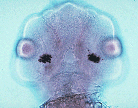Person
Raymond, Pamela
|

|
Biography and Research Interest
Professor Raymond retired in June, 2017.
The research in Pamela Raymond's laboratory was concerned with retinal neurogenesis, neural stem cells, and regeneration. The overall objective was to understand the molecular basis of cell-cell interactions that regulate retinal neurogenesis (the formation of neurons) and neuronal specificity (the expression of differentiated cellular features) during development and regeneration. We used zebrafish as a model system, and we concentrated on a selected subset of molecular interactions that are likely to be involved in determination of cell fate in retinal stem cells and progenitor cells: cell surface signaling molecules - such as the cadherin family of adhesion molecules, the Notch-Delta signaling pathway, and other signaling systems, and transcriptional regulators - especially the family of paired-like homeodomain proteins that have been implicated in the regionalization of brain territories, the control of proliferation, and the determination of specified progenitor cells and differentiated cell fates. We were also interested in understanding the cellular and molecular mechanisms of neuronal pattern formation, especially the formation of precise arrays of cone photoreceptors in the teleost fish retina.
The research in Pamela Raymond's laboratory was concerned with retinal neurogenesis, neural stem cells, and regeneration. The overall objective was to understand the molecular basis of cell-cell interactions that regulate retinal neurogenesis (the formation of neurons) and neuronal specificity (the expression of differentiated cellular features) during development and regeneration. We used zebrafish as a model system, and we concentrated on a selected subset of molecular interactions that are likely to be involved in determination of cell fate in retinal stem cells and progenitor cells: cell surface signaling molecules - such as the cadherin family of adhesion molecules, the Notch-Delta signaling pathway, and other signaling systems, and transcriptional regulators - especially the family of paired-like homeodomain proteins that have been implicated in the regionalization of brain territories, the control of proliferation, and the determination of specified progenitor cells and differentiated cell fates. We were also interested in understanding the cellular and molecular mechanisms of neuronal pattern formation, especially the formation of precise arrays of cone photoreceptors in the teleost fish retina.
Non-Zebrafish Publications
